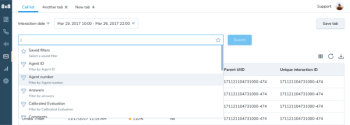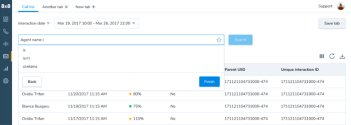Use Search
The “Filter by” drop-down is replaced with a long search bar. Click inside the search bar to reveal filters. The “Saved filters” option is always displayed at the top. Users can choose a filter as they scroll through the list, or they can start typing the filter name to narrow down the number of results. Filters are shown in alphabetical order.
Operators specify how filter criteria relate to one another; for example, "Evaluator is John Doe". In this example, the filter we use is "Evaluator", the operator we use is "is", and the value we filter against is the evaluator name "John Doe". Filters are executed by clicking “Search”.
The key element of the new design is its new search bar. The search bar allows for simplistic design, and incorporates extensive power, which users are intuitively able to discover on their own!
To let users perform a comprehensive search, the search process makes use of filters, operators, and values to refine a search. These three components all follow specific principles.
Note: The new search capabilities of 8x8 Speech Analytics are only available in the 5.0 release.
Filters
- Search is disabled if the user is building or editing a filter.
- Clicking outside of the input or suggestion box cancels the current query.
- The “Saved filters” option is always at the top.
- Filters are presented alphabetically.
- Background colors are shown on hover to help the user select the correct option.
- Results are narrowed down after three characters.
- Any part of a word can be matched.
Operators
- Operators are filter-specific.
- Clicking “Back” returns the user to selecting a filter.
- Clicking “Finish” completes the filter, whether it was fully entered by the user or not.
Values
- Values are filter-specific.
- Users can type to narrow down the listing.
- Clicking “Back” returns the user to operators.
- Clicking “Finish” closes the drop-down list, and the filter becomes a chip.
Search Using Chips
Chips display when a formulated query is valid. Chips can be searched against, and one or more chips can be saved as queries. Chips are shown in the search bar, and can be edited or deleted by clicking the “X” icon. If chips contain partial selections, they can also be saved, but they show up with a dotted border. A filter can contain one or more chips. Every saved filter requires a name. The feature is controlled by a white star icon located at the end of the search bar. When a filter is saved, the star becomes yellow. Later on, users can retrieve the saved filter and continue editing. The filter chips can be edited with a simple click. Clicking “Back” enables the user to return to a previous selection at any time.
Examples of how chips are used:
- A normal chip is shown here, which is completed, and ready to be saved or searched.

- When you hover over a chip, you can edit it.
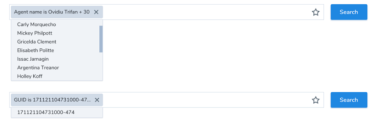
- You can add more chips and create complex queries with ease. Filters are comprehensive and highly customizable. A single filter can reach impressive levels of precision. If the user is not sure of the exact content they need to retrieve, using fewer filters can make search more effective, but if an agent knows exactly what they are looking for, combining a high number of filter criteria significantly narrows down search results. Once you create your first chip, and/or options are available to connect multiple criteria.
- All operators are filter-specific. The user only has the ability to choose operators that create logical queries. All it takes is for the user to start typing and watch the filter being built, and the results display in a matter of seconds.
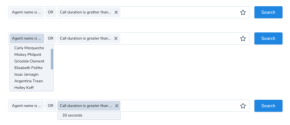
- Loading a saved filter works in a similar way to adding a filter. The option to load a saved filter appears in the suggestion box at the top when a user focuses on the search input. Filters are highly customizable, and the user is empowered to save single or multiple filters, and name filters. They can also load multiple filters, and delete saved filters.
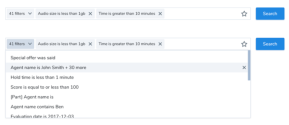
- Here is an example of chips being grouped with a filter. You can use a saved filter, and then apply more chips to refine your search!
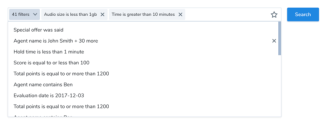
- Search improvements also reflect in the ability to save filters that are not completely written. Users can select the filter and the operator, and save this as a custom filter to always find it in the list. For example, the filter "Agent name is" can be saved by clicking “Finish”. When you save the filter, the drop-down closes, and the filter becomes a chip.

